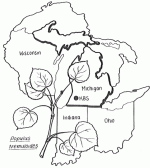The 1989 field season at the Kellogg Biological Station’s LTER site in agricultural ecology has seen the first full set of main experimental plots installed, the start of baseline sampling activities, and the continued development of sub- and spinoff projects. Investigators at the site have also been busy analyzing results from a massive year 1 spatial variability study.
All LTER-associated projects at KBS fall under the global hypothesis that agronomic management based on ecological concepts can effectively substitute for the current reliance on chemical subsidies in production- level agronomic systems. One of the corollaries that falls out of this hypothesis is that herbicide subsidies can be minimized by manipulating crop-weed interactions, pesticide subsidies by manipulating plant-insect-pathogen interactions, and nutrient subsidies by manipulating plant microbe-soil interactions.
The approximately 30 Ph.D.-level researchers actively associated with the project are organized into three working groups centered on these topic areas: plant competition, herbivory and pathogenesis, nutrient availability—plus a fourth centered on system wide outputs and modeling. Working group leaders coordinate activities among the groups.
Main Field Plots
The main field plots, in which specific hypotheses that follow from the global hypothesis are addressed, are located on a 40- hectare site that has been in high-input, continuous corn production for the past several decades. This spring seven types of treatment plots were established on this site, each 1 hectare and replicated in one of six blocks. Treatments 1 and 2, both corn-soybean rotations, represent conventional, high-input grain production; one treatment is conventionally tilled (moldboard plowed) and the other is “no-tilled.”
Treatments 3 and 4 represent low-chemical-input and zero- chemical -input treatments; both are corn-soybean-wheat rotations with a legume (hairy vetch) cover crop.
Treatments 5 and 6 are the perennial biomass plots; one is planted in alfalfa, the other in fast-growing Populus trees. Treatment 7 is a native succession, abandoned after plowing last spring.
Process-Level Subplots Within each of the main treatment plots are subplots established to address specific process-level hypotheses. In all of the grain treatments, for example, are subplots with and without fertilizer and with and without herbicide to test hypotheses about resource allocation and competitive interactions among crop and weed species.
In the Populus plots are subplots planted to different stem densities and microplots treated with radioisotopes to examine within-plant C/N allocation, root turnover, and decomposition dynamics. In ancillary till/no-till subplots, 4 m3 in-ground, undisturbed profile drainage lysimeters are being installed to test hypotheses about nutrient turnover, plant uptake, and microbial dynamics within soil wetting fronts. In ancillary wheat subplots, different 2-4, D concentrations are used to study mechanisms of gene transfer in soil.
Research Awards
In recent months KBS LTER researchers have received a number of research awards for work centered at the site. Among these are grants overseen by:
- Stuart Gage (“Influence of local landscape structure on the distribution, abundance and movement of insects”)
- Kay Gross and Kurt Pregitzer (“Mechanisms of belowground competition in plants: linking form and function’)
- Eldor Paul and Kurt Pregitzer (“Fine root and soil organic matter turnover in C, N, and P cycling of Populus plantations”)
- Phil Robertson and Al Smucker (“Process-level interactions in agricultural ecosystems”)
- Mark Scriber and Matthew Ayres (“Papilio glaucus in temperate and subarctic forests: host plant quality and temperature adaptations”)
- Jim Tiedje and Bill Holben (“Molecular approach to understanding genetic response of soil population selection”)
The Kellogg LTER site is also the primary field site of the Science and Technology Center for Microbial Ecology, with which seven LTER scientists are associated as principal or co-investigators.
For further information contact Phil Robertson, WE. Kellogg Biological Station, Michigan State University, Hickory Corners, Ml 49060-9516.

 Enlarge this image
Enlarge this image
